Cosnaíonn drochdhearadh ceistneora na milliúin euro d’eagraíochtaí gach bliain i gcinntí lochtacha agus am amú. Léiríonn taighde ó Chlár Taighde Suirbhé Harvard nach mbíonn suirbhéanna atá curtha le chéile go dona in ann sonraí úsáideacha a bhailiú amháin—go gcuireann siad lucht cinnteoireachta ar míthreoir go gníomhach le freagraí claonta, neamhiomlána, nó míthuiscintí.
Cibé acu gairmí AD thú atá ag tomhas rannpháirtíocht fostaithe, bainisteoir táirgí atá ag bailiú aiseolais úsáideoirí, taighdeoir atá ag déanamh staidéir acadúla, nó oiliúnóir atá ag meastóireacht ar thorthaí foghlama, tá na prionsabail deartha ceistneora a gheobhaidh tú anseo bunaithe ar 40+ bliain de thaighde eimpíreach ó institiúidí ar nós Ionad Taighde Pew, Coláiste Impiriúil Londain, agus modheolaithe suirbhé ceannródaíocha.
Ní bhaineann sé seo le suirbhéanna "maith go leor" a chruthú. Baineann sé seo le ceistneoirí a dhearadh a líonann freagróirí i ndáiríre, a chuireann deireadh le claontacht chognaíoch choitianta, agus a sholáthraíonn faisnéis inghníomhaithe ar féidir leat muinín a bheith agat astu.
Clár na nÁbhar
- Cén fáth a dteipeann ar an gcuid is mó de na ceistneoirí (agus ní gá go dteipeann ortsa)
- Ocht Sainaithne Neamh-idirbheartaíochta de Cheistneoirí Gairmiúla
- An Próiseas Dearaidh Ceistneora Seacht gCéim atá Tacaithe le Taighde
- Céim 1: Sainmhínigh Cuspóirí le Beachtas Máinliachta
- Céim 2: Ceisteanna a Fhorbairt a Dhíbreoidh Claonadh Cognaíoch
- Céim 3: Formáid le haghaidh Ordlathas Amhairc agus Inrochtaineachta
- Céim 4: Déan Tástáil Phíolótach Dhian
- Céim 5: Imscaradh le Dáileadh Straitéiseach
- Céim 6: Déan anailís ar shonraí le dian-staitisticí
- Céim 7: Léirmhíniú a dhéanamh ar na Torthaí laistigh den Chomhthéacs Ceart
- Gaistí Coitianta i nDearadh Ceistneoirí (agus Conas iad a Sheachaint)
- Conas Ceistneoir a Chruthú in AhaSlides
- Ceisteanna Coitianta
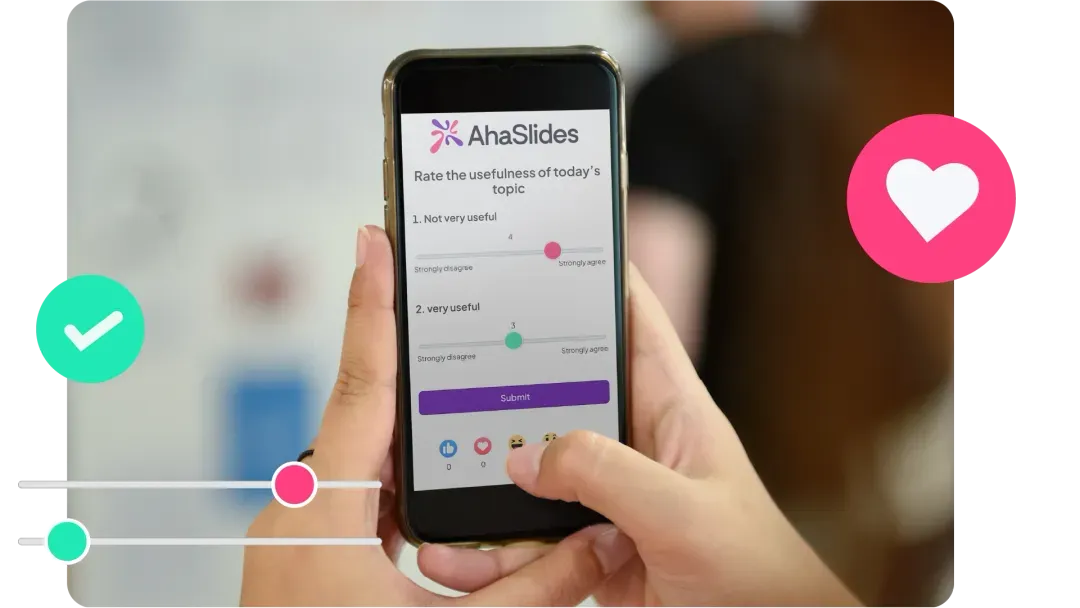
Cén fáth a dteipeann ar an gcuid is mó de na ceistneoirí (agus ní gá go dteipeann ortsa)
De réir taighde suirbhé ó Ionad Taighde Pew, ní ealaín í forbairt ceistneora—is eolaíocht í. Ach is ar bhealach iomasach a thagann formhór na n-eagraíochtaí chun cinn maidir le dearadh suirbhé, rud a fhágann go bhfuil trí theip chriticiúla ann:
- Claonadh freagartha: Treoraíonn ceisteanna freagróirí go neamhbheartaithe i dtreo freagraí áirithe, rud a fhágann nach bhfuil luach ar bith ar na sonraí.
- Ualach an fhreagróra: Is cúis le rátaí críochnaithe ísle agus droch-chaighdeán freagraí suirbhéanna a bhraitheann deacair, a thógann go leor ama, nó a bhíonn tuirseach go mothúchánach.
- Earráid tomhais: Ciallaíonn ceisteanna doiléire go ndéanann freagróirí léirmhíniú difriúil orthu, rud a fhágann nach féidir anailís bhríoch a dhéanamh ar do shonraí.
An dea-scéal? Tá prionsabail shonracha, in-athchruthaithe aimsithe ag taighde ó Imperial College London agus ó institiúidí ceannródaíocha eile a chuireann deireadh leis na fadhbanna seo. Lean iad, agus is féidir le rátaí freagartha do cheistneora méadú 40-60% agus feabhas suntasach a chur ar cháilíocht na sonraí ag an am céanna.
Ocht Sainaithne Neamh-idirbheartaíochta de Cheistneoirí Gairmiúla
Sula dtosaíonn tú ag forbairt ceisteanna, cinntigh go gcomhlíonann creat do cheistneora na critéir seo atá bunaithe ar fhianaise:
- Soiléireacht chriostail: Tuigeann freagróirí go díreach cad atá á iarraidh agat. Is é an débhríocht namhaid na sonraí bailí.
- Giorracht straitéiseach: Gonta gan comhthéacs a íobairt. Léiríonn taighde Harvard go mbíonn ráta críochnaithe 25% níos airde ag suirbhéanna 10 nóiméad ná mar a bhíonn ag leaganacha 20 nóiméad.
- Sonrachas léasair: Tugann ceisteanna ginearálta freagraí doiléire. Tá "Cé chomh sásta atá tú?" lag. Tá "Cé chomh sásta atá tú leis an am freagartha ar do thicéad tacaíochta deireanach?" láidir.
- Neodracht neamhthrócaireach: Bain an teanga tosaigh. Tugann "Nach aontaíonn tú go bhfuil ár dtáirge den scoth?" isteach claontacht. Ní dhéanann "Cén rátáil a thabharfá ar ár dtáirge?".
- Ábharthacht chuspóireach: Caithfidh gach ceist díriú go díreach ar chuspóir taighde. Mura féidir leat a mhíniú cén fáth a bhfuil tú á cur, scrios í.
- Sreabhadh loighciúil: Grúpáil ceisteanna gaolmhara le chéile. Bog ó cheisteanna ginearálta go ceisteanna sonracha. Cuir ceisteanna déimeagrafacha íogaire ag an deireadh.
- Sábháilteacht shíceolaíoch: I gcás topaicí íogaire, cinntigh anaithnideacht agus rúndacht. Cuir bearta cosanta sonraí in iúl go soiléir (tábhacht le comhlíonadh GDPR).
- Freagra gan stró: Déan freagairt iomasach. Bain úsáid as ordlathas amhairc, spás bán, agus formáidí soiléire freagartha a oibríonn go réidh ar fud gléasanna.
An Próiseas Dearaidh Ceistneora Seacht gCéim atá Tacaithe le Taighde
Céim 1: Sainmhínigh Cuspóirí le Beachtas Máinliachta
Cruthaíonn cuspóirí doiléire ceistneoirí gan úsáid. Tá "Tuiscint a fháil ar shástacht chustaiméirí" ró-leathan. Ina áit sin: "Tomhais NPS, sainaithin na 3 phointe frithchuimilte is mó i dtaithí ar thosú, agus cinntigh dóchúlacht athnuachana i measc custaiméirí fiontar."
Creat le haghaidh cuspóirí a shocrú: Soiligh do chineál taighde (taiscéalaíoch, tuairisciúil, mínitheach, nó réamhinsinteach). Sonraigh an fhaisnéis chruinn atá ag teastáil. Sainmhínigh an daonra sprice go beacht. Cinntigh go dtreoraíonn cuspóirí torthaí intomhaiste, ní próisis.
Céim 2: Ceisteanna a Fhorbairt a Dhíbreoidh Claonadh Cognaíoch
Léiríonn taighde ó Choláiste Impiriúil go bhfuil formáidí freagartha aontaíonn-neamhaontaíonn i measc na "bealaí is measa chun míreanna a chur i láthair" toisc go dtugann siad isteach claonadh toilithe - claonadh ag freagróirí aontú beag beann ar an ábhar. Is féidir leis an locht amháin seo do shraith sonraí iomlán a chur ar neamhní.
Prionsabail deartha ceisteanna atá bunaithe ar fhianaise:
- Míreanna focal mar cheisteanna, ní ráitis: "Cé chomh cabhrach is a bhí ár bhfoireann tacaíochta?" níos fearr ná "Bhí ár bhfoireann tacaíochta cabhrach (aontaím/ní aontaím)."
- Bain úsáid as scálaí lipéadaithe ó bhéal: Lipéadaigh gach rogha freagartha ("Ní raibh sé cabhrach ar chor ar bith, Beagán cabhrach, Measartha cabhrach, An-chabhrach, Thar a bheith cabhrach") seachas críochphointí amháin. Laghdaíonn sé seo earráid tomhais.
- Seachain ceisteanna dé-bharrúla: "Cé chomh sásta agus cé chomh gafa atá tú?" a fhiafraíonn dhá rud. Scar iad.
- Cuir formáidí ceisteanna cuí i bhfeidhm: Scálaí dúnta le haghaidh sonraí cainníochtúla (anailís níos éasca). Scálaí oscailte le haghaidh léargais cháilíochtúla (comhthéacs níos saibhre). Scálaí Likert le haghaidh dearcthaí (5-7 bpointe molta).
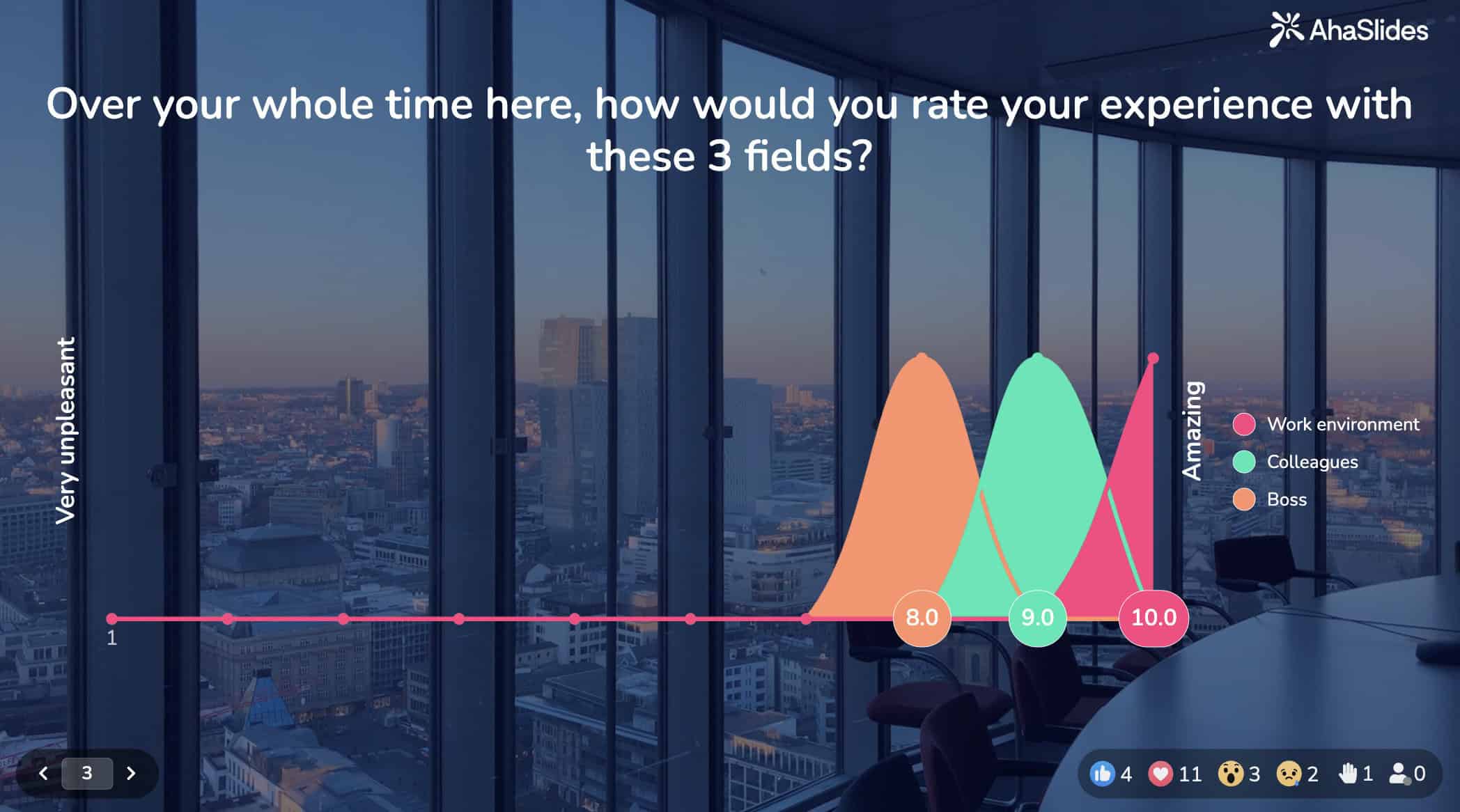
Céim 3: Formáid le haghaidh Ordlathas Amhairc agus Inrochtaineachta
Léiríonn taighde go mbíonn tionchar díreach ag dearadh amhairc ar cháilíocht na bhfreagraí. Méadaíonn droch-fhormáidiú an t-ualach cognaíoch, rud a fhágann go mbíonn na freagróirí sásta — ag soláthar freagraí ísealchaighdeáin díreach chun críochnú.
Treoirlínte formáidithe criticiúla:
- Spásáil amhairc chomhionann: Coinnigh achair chomhionanna idir pointí scála chun comhionannas coincheapúil a threisiú agus claontacht a laghdú.
- Roghanna neamhshubstaintiúla ar leithligh: Cuir spás breise roimh "N/B" nó "Is fearr liom gan freagra a thabhairt" chun idirdhealú a dhéanamh eatarthu go hamhairc.
- Spás bán flaithiúil: Laghdaíonn sé tuirse chognaíoch agus feabhsaíonn sé rátaí críochnaithe.
- Táscairí dul chun cinn: I gcás suirbhéanna digiteacha, taispeáin céatadán críochnaithe chun an spreagadh a choinneáil.
- Optamú móibíleach: Tagann breis is 50% de na freagraí suirbhé ó ghléasanna soghluaiste anois. Déan tástáil dhian.
Céim 4: Déan Tástáil Phíolótach Dhian
Pew Ionad Taighde úsáideann sé réamhthástáil fhairsing trí agallaimh chognaíocha, grúpaí fócais, agus suirbhéanna píolótacha roimh imscaradh iomlán. Gabhann sé seo focail débhríocha, formáidí mearbhallacha, agus saincheisteanna teicniúla a scriosann cáilíocht sonraí.
Tástáil phíolótach le 10-15 ionadaí ón daonra sprice. Déan am críochnaithe a thomhas, ceisteanna doiléire a aithint, sreabhadh loighciúil a mheas, agus aiseolas cáilíochtúil a bhailiú trí chomhráite leantacha. Athbhreithnigh go hathchleachtach go dtí go n-imíonn an mearbhall.
Céim 5: Imscaradh le Dáileadh Straitéiseach
Bíonn tionchar ag an modh dáilte ar rátaí freagartha agus ar cháilíocht sonraí. Roghnaigh bunaithe ar do lucht féachana agus íogaireacht an ábhair:
- Suirbhéanna digiteacha: Is tapúla, is cost-éifeachtaí, oiriúnach le haghaidh inscálaitheachta agus sonraí fíor-ama.
- Dáileadh ríomhphoist: Ard-rochtain, roghanna pearsanaithe, méadrachtaí inrianaithe.
- Riarachán duine le duine: Rátaí freagartha níos airde, soiléiriú láithreach, níos fearr do thopaicí íogaire.
Leid rannpháirtíochta gairmiúla: Bain úsáid as ardáin suirbhé idirghníomhacha a chuireann ar chumas rannpháirtíocht shioncrónach agus asioncrónach agus léirshamhlú láithreach ar thorthaí. Uirlisí cosúil le AhaSlides is féidir a bheith oiriúnach go hiontach.
Céim 6: Déan anailís ar shonraí le dian-staitisticí
Tiomsaigh freagraí go córasach ag baint úsáide as bogearraí scarbhileog nó uirlisí anailíse speisialaithe. Seiceáil le haghaidh sonraí atá ar iarraidh, eisceachtaí, agus neamhréireachtaí sula dtéann tú ar aghaidh.
I gcás ceisteanna dúnta, ríomh minicíochtaí, céatadáin, meáin agus modhanna. I gcás freagraí oscailte, cuir códú téamach i bhfeidhm chun patrúin a aithint. Bain úsáid as tras-thábláil chun caidrimh idir athróga a nochtadh. Doiciméadaigh fachtóirí a mbíonn tionchar acu ar léirmhíniú amhail rátaí freagartha agus ionadaíocht dhéimeagrafach.
Céim 7: Léirmhíniú a dhéanamh ar na Torthaí laistigh den Chomhthéacs Ceart
Athchuairt a thabhairt ar chuspóirí bunaidh i gcónaí. Téamaí comhsheasmhacha agus caidrimh staitistiúla suntasacha a shainaithint. Teorainneacha agus tosca seachtracha a thabhairt faoi deara. Samplaí freagartha a lua a léiríonn léargais thábhachtacha. Bearnaí a bhfuil gá le tuilleadh taighde a shainaithint. Torthaí a chur i láthair le rabhadh cuí maidir le hinghinearáltacht.
Gaistí Coitianta i nDearadh Ceistneoirí (agus Conas iad a Sheachaint)
- Ceisteanna ceannródaíocha: "Nach gceapann tú go bhfuil X tábhachtach?" → "Cé chomh tábhachtach is atá X duit?"
- Eolas toimhde: Sainmhínigh téarmaí teicniúla nó acrainmneacha—níl a fhios ag gach duine cad is brí leis an tionscal.
- Roghanna freagartha forluiteacha: Cruthaíonn "0-5 bliana, 5-10 mbliana" mearbhall. Bain úsáid as "0-4 bliana, 5-9 mbliana".
- Teanga luchtaithe: Tugann "Ár dtáirge nuálach" claontacht isteach. Fan neodrach.
- Fad iomarcach: Laghdaíonn gach nóiméad breise rátaí críochnaithe faoi 3-5%. Tabhair urraim d'am an fhreagróra.
Conas Ceistneoir a Chruthú in AhaSlides
Seo a leanas 5 chéim shimplí chun suirbhé tarraingteach tapa a chruthú ag baint úsáide as scála Likert. Is féidir leat an scála a úsáid le haghaidh suirbhéanna sástachta fostaithe/seirbhíse, suirbhéanna forbartha táirgí/gnéithe, aiseolas mac léinn, agus go leor eile👇
Céim 1: Cláraigh le haghaidh AhaSlides saor in aisce áireamh.
Céim 2: Cruthaigh cur i láthair nua nó ceann chuig ár 'Leabharlann teimpléad' agus grab teimpléad amháin ón rannán 'Suirbhéanna'.
Céim 3: I do chur i láthair, roghnaigh an 'Scálaí' cineál sleamhnáin.
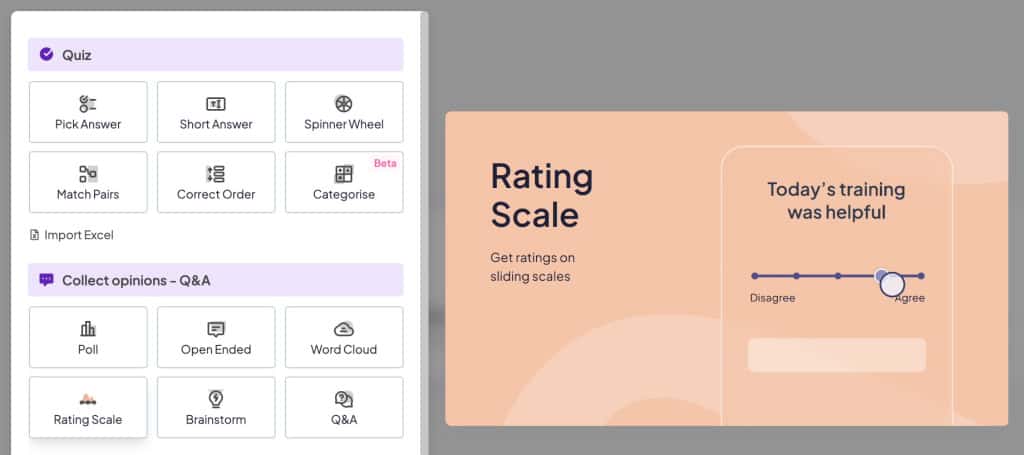
Céim 4: Cuir isteach gach ráiteas le go ndéanfaidh do rannpháirtithe rátáil agus socraigh an scála ó 1-5.
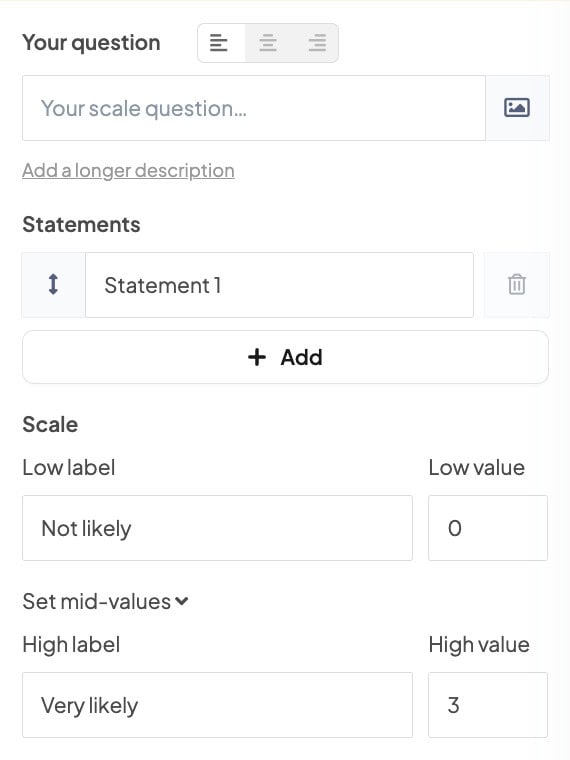
Céim 5: Más mian leat iad a rochtain a fháil ar do shuirbhé láithreach, cliceáil an 'Chur i láthaircnaipe ' ionas gur féidir leo é a fheiceáil air a ngléasanna. Is féidir leat dul chuig 'Socruithe' - 'Cé a ghlacann an ceannas' - agus an rogha a dhéanamh 'Lucht Féachana (féin-luas)' rogha tuairimí a bhailiú am ar bith.
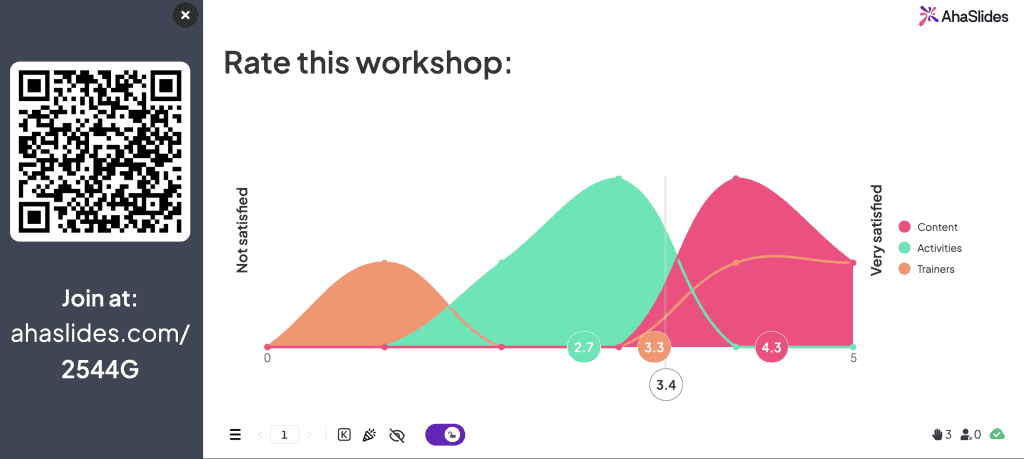
💡 Leid: Cliceáil ar an 'TorthaíCuirfidh an cnaipe seo ar do chumas na torthaí a onnmhairiú go Excel/PDF/JPG.
Ceisteanna Coitianta
Cad iad na cúig chéim le ceistneoir a dhearadh?
Is iad na cúig chéim le ceistneoir a dhearadh ná #1 - Sainmhínigh na cuspóirí taighde, #2 - Déan cinneadh ar fhormáid an cheistneora, #3 - Forbair ceisteanna soiléire agus gonta, #4 - Eagraigh na ceisteanna go loighciúil agus #5 - Déan an ceistneoir a bheartú agus a bheachtú .
Cad iad na 4 chineál ceistneoir sa taighde?
Tá 4 chineál ceistneoirí sa taighde: Struchtúrtha - Neamhstruchtúrtha - Leath-struchtúrtha - Hibrid.
Cad iad 5 cheist mhaith suirbhé?
Na 5 cheist shuirbhé mhaith - cad, cén áit, cén uair, cén fáth, agus conas atá bunúsach ach iad a fhreagairt sula dtosaíonn tú ar do shuirbhé chuideodh sé le toradh níos fearr a thiomáint.
